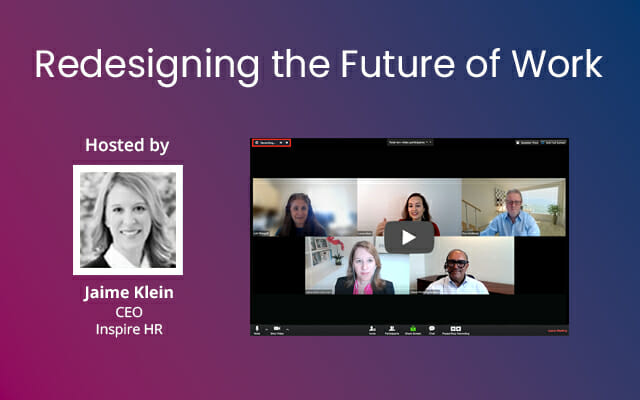
Managing Employee Illness: When Culture is the Cure for the Common Cold
FEB 08, 2019
There has been plenty of debate about the merits of different sick leave policies, but there are a few things we know for sure – employees will get sick, employee illness will impact work, and sick days are not what they used to be. Gone are the days of recovery by a calm, chicken soup-induced sleep. With the lines between work and home increasingly blurred, I get more questions than ever about managing employee illness. While I don’t have a cure for the common cold, I have a number of recommendations for creating cultures that promote both healing and productivity.
My primary recommendation is to look beyond policy and focus on creating a culture that “enables employees to do their best work.” This phrase is incredibly deliberate. “Enabling employees” acknowledges the importance of offering resources and support when illness strikes. “To do their best work” acknowledges our commitment to shareholders and the bottom line. While every organization will be different, here are some guidelines to create a culture that strikes the right balance.

1. Stay home.
Your star project manager shows up with a red nose, a hacking cough and a pocket full of tissues. You’ll have to keep your distance if you don’t want to catch whatever he’s got, but you are relieved he is there to run the team checkpoint.
Cold and flu in the winter, stomach viruses in the summer. While it may seem obvious, many employees need to be told to leave their germs at home. We are all under tremendous pressure to produce at work. With that in mind, it is actually not surprising that some employees feel the need to be in the office while sick. To make matters worse, some studies show trendy open floor plans might even increase the likelihood of getting sick at work. The most basic advice I give to our clients is to encourage, even require, that employees stay home when they are contagious. Ideally, this is not just preached but practiced. Consider the impact of a high-profile leader staying home, or encouraging employees to stay home due to illness. If you want to keep employee illness to a minimum, keep it out of the office by making it clear that staying home is the preferred option.
2. Rest and recover.
You just hung up with your boss to let her know that you have the flu. Perhaps your ears are clogged…did she say “get well” or “get to work?”
The New York Times recently published The Death of the Sick Day, highlighting how “working from home” is replacing traditional recovery from illness. Remote work tools have become so accessible, employees are often expected to be online and responsive while sick. Instead of the good old fashioned sick day from our youth – full of care, cartoons and chicken soup – we find ourselves on conference calls and email most of the day. In reality, we don’t end up doing our best work and we don’t get much rest either – a lose-lose situation. I encourage our clients to pull back from this trend and create a culture where rest is rewarded. Train leaders to boldly encourage employees to take true recovery time. Picture a scenario where a sick employee dials into the team conference call. Instead of thanking her for being there despite being sick, respectfully discourage her participation. “I appreciate your willingness to join us, but it would mean so much to me if you would just rest and get better.” According to the Bureau of Labor Statistics, 65% of US employees have a sick day benefit. What we need to do now is take the shame out of using them.
3. Prevent burnout.
Your vendor calls saying your project will, unfortunately, be delayed. Not just because the project manager is sick, but the entire team is sick.
The first thing I think of when I hear about entire work teams getting sick is burn-out. A recent Gallup study of “nearly 7,500 full-time employees found that 23 percent reported feeling burned out at work very often or always, while an additional 44 percent reported feeling burned out sometimes.” With over 60% of employees feeling some level of burn out, we need to consider whether our work might be making us sick. This chronic, repeat pattern should be addressed by identifying the root cause and helping teams find ways to work smarter. In an interview, Warren Buffett and Bill Gates both agreed “busy is the new stupid.” A back-to-back calendar is not necessarily a badge of honor. At a minimum, we are robbing our minds of rest, during which we do some of our best thinking. Worse, we may be causing burnout related illnesses. If requesting more resources is not an option, continuously seek out tools to drive efficiency.
4. Manage chronic illness.
Your lead programmer was just diagnosed with fibromyalgia. She is still learning how to manage the pain and is experiencing periods of extreme fatigue. You are so happy to have her back that you are eager to find a way to make it work.
According to a RAND study, “60 percent of American adults now live with at least one chronic condition; 42 percent have more than one.” Chronic illness, whether physical or mental, can be stressful for both employee and manager. In my experience, there is an art to getting this right by focusing on creative ways to help a chronically ill employee “do their best work.” For example, if an employee has an illness with unpredictable episodes, consistently leverage collaboration tools to enable appointed co-workers to pick up on projects with full access to background and information. Perhaps an employee has a planned medical intervention that will result in an extended leave. Allow that employee to frontload work where possible to help them maintain ownership and control over their work while they are available. The key is communicating with employees about exactly what they need during the work day to be at their best. Even something as small as a daily 30-minute break could make a huge difference in an employee’s performance, while also engendering a true sense of loyalty.
The most obvious concern leaders will have when it comes to letting people detach and get well is the pressure to get work done. While this is a real concern, it is a problem worth solving. When we don’t give employees the time and space to heal, we end up with sub-optimal work and team-level burnout. In today’s competitive labor market, you will likely see some costly turnover as well. Planning ahead for inevitable illness goes a long way. Make good use of collaboration and redundancy tools or even temporary, fractional talent. With these tools in place, a five-minute conversation with the sick employee can set your back-up plan into motion, giving your organization the opportunity to “reward rest.”
There is no question the lines are blurred. We build offices that look like our living rooms and our home looks like our offices. We work during our commutes and have yoga and chair massages at work. Without visual separation, it’s no wonder we cannot find the boundaries for when our minds are at work vs. rest. With leadership setting the tone and some new tools, we can put meaning back in the words “get well.” The result will be stronger employees, productive teams and a magnetic culture that attracts the best talent. If you are interested in building a culture that “rewards rest,” contact me at jaime@inspirehumanresources.com or (917) 612-8571.







